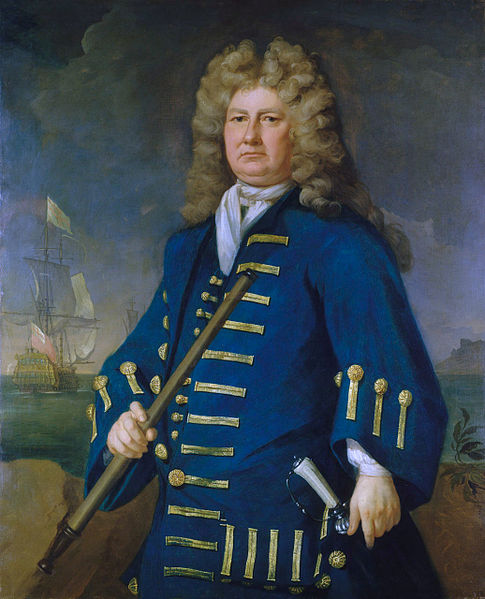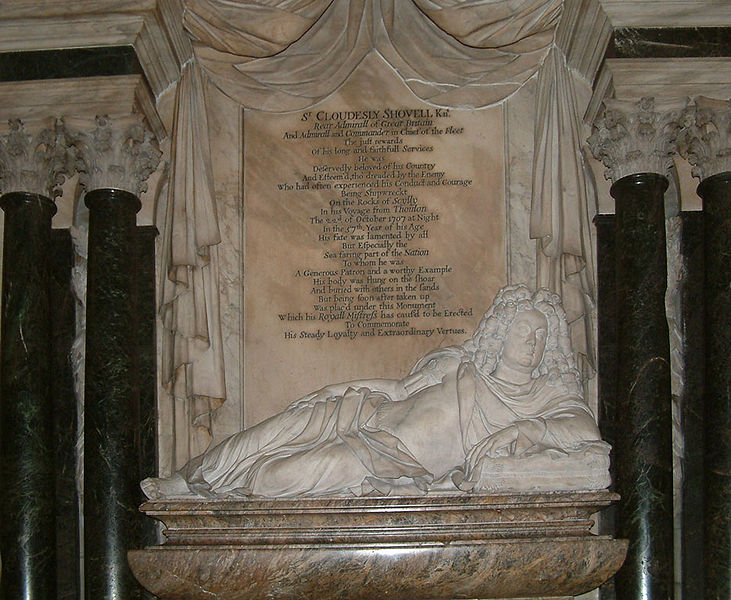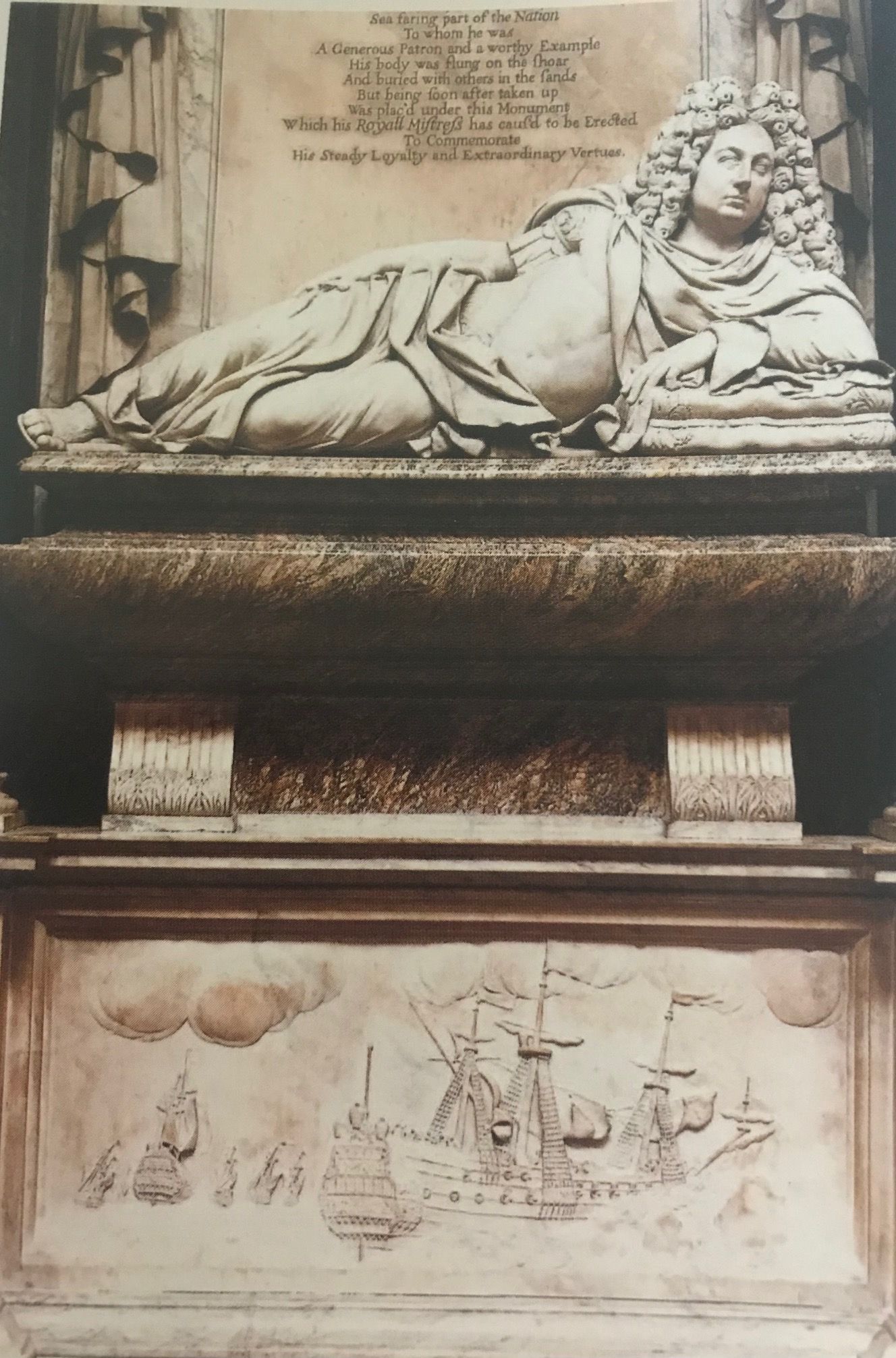There are many different versions used for the spelling of both his Christian name and surname. He used the spelling Cloudesley Shovell in his will written on 20 April 1701 when he was fifty. Both his father and his widow also spelt their surname as Shovell in their wills. The Christian name Cloudesley was often indistinctly signed which may have given rise to variety of spellings used by subsequent biographers. Nonetheless, spellings such as Cloudisley and Shovel are occasionally seen in books and articles on him.
When returning with the fleet to England after the campaign to Toulon, Shovell's ship, HMS Association, at 8 pm on 22 October (November 2, by the modern calendar) 1707, struck on the rocks near the Isles of Scilly along with several other ships, and was seen by those on board HMS St George to go down in three or four minutes' time, not a soul being saved of 800 men that were on board. With four large ships (HMS Association, HMS Eagle, HMS Romney and HMS Firebrand) and nearly 2,000[8] sailors lost that night, the Scilly naval disaster was one of the greatest maritime disasters in British history. It was later determined that the main cause of the disaster was the navigators' inability to accurately calculate their longitude.
What exactly happened to Sir Cloudesley Shovell has never been discovered. Considering that his body, and the bodies of both his stepsons were all found in the same cove, almost seven miles from where his ship was wrecked, the most likely scenario is that Shovell left his ship in one of its boats, along with his two Narborough stepsons, the captain of the Association, Edmund Loades, and a pet dog and that they were drowned while trying to get to shore. Shovell's body, along with the bodies of his two stepsons and that of Captain Loades, washed up on Porthellick Cove on St Mary's the following day. A small memorial was later erected at this site. Shovell's body was identified by the Purser of HMS Arundel who knew the admiral well. It was identified by "a black mole under his left ear, also by the first joint of one of his forefingers being broken inwards. He had likewise a shot in his right arm, another in his left thigh". The circumstances under which the his remains were found gave rise to stories (see below). Shovell was temporarily buried on the beach at Porthellick Cove (see image).By order of Queen Anne the body was later exhumed and brought back aboard HMS Salisbury to Plymouth, where it was embalmed by Dr James Yonge. It was later carried in state to London. During the journey from the West Country, large crowds turned out to pay their respects. On 22 December 1707 he was interred in Westminster Abbey. His large marble monument in the south choir aisle was sculpted by Grinling Gibbons. His two stepsons were buried in Old Town Church on St Mary's. The Council of the Scilly Isles commemorated the tercentenary of the disaster in 2007
There are many different versions used for the spelling of both his Christian name and surname. He used the spelling Cloudesley Shovell in his will written on 20 April 1701 when he was fifty. Both his father and his widow also spelt their surname as Shovell in their wills. The Christian name Cloudesley was often indistinctly signed which may have given rise to variety of spellings used by subsequent biographers. Nonetheless, spellings such as Cloudisley and Shovel are occasionally seen in books and articles on him.
When returning with the fleet to England after the campaign to Toulon, Shovell's ship, HMS Association, at 8 pm on 22 October (November 2, by the modern calendar) 1707, struck on the rocks near the Isles of Scilly along with several other ships, and was seen by those on board HMS St George to go down in three or four minutes' time, not a soul being saved of 800 men that were on board. With four large ships (HMS Association, HMS Eagle, HMS Romney and HMS Firebrand) and nearly 2,000[8] sailors lost that night, the Scilly naval disaster was one of the greatest maritime disasters in British history. It was later determined that the main cause of the disaster was the navigators' inability to accurately calculate their longitude.
What exactly happened to Sir Cloudesley Shovell has never been discovered. Considering that his body, and the bodies of both his stepsons were all found in the same cove, almost seven miles from where his ship was wrecked, the most likely scenario is that Shovell left his ship in one of its boats, along with his two Narborough stepsons, the captain of the Association, Edmund Loades, and a pet dog and that they were drowned while trying to get to shore. Shovell's body, along with the bodies of his two stepsons and that of Captain Loades, washed up on Porthellick Cove on St Mary's the following day. A small memorial was later erected at this site. Shovell's body was identified by the Purser of HMS Arundel who knew the admiral well. It was identified by "a black mole under his left ear, also by the first joint of one of his forefingers being broken inwards. He had likewise a shot in his right arm, another in his left thigh". The circumstances under which the his remains were found gave rise to stories (see below). Shovell was temporarily buried on the beach at Porthellick Cove (see image).By order of Queen Anne the body was later exhumed and brought back aboard HMS Salisbury to Plymouth, where it was embalmed by Dr James Yonge. It was later carried in state to London. During the journey from the West Country, large crowds turned out to pay their respects. On 22 December 1707 he was interred in Westminster Abbey. His large marble monument in the south choir aisle was sculpted by Grinling Gibbons. His two stepsons were buried in Old Town Church on St Mary's. The Council of the Scilly Isles commemorated the tercentenary of the disaster in 2007
Family Members
Advertisement
Advertisement








